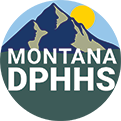FOR IMMEDIATE RELEASE
Date: April 17 2025
Contact: Jon Ebelt, Communications Director, DPHHS, (406) 444-0936, (406) 461-3757
jebelt@mt.gov
State Health Officials Report Significant Increase in Overdoses
DPHHS committed to expanding recovery and treatment programs
HELENA, Mont. – Department of Public Health and Human Services (DPHHS) officials are raising awareness about an identified increase in overdoses across the state and reminding Montanans of available recovery and treatment programs.
“This current overdose spike serves as a startling reminder of the deadly consequences that fentanyl and opioid overdoses have for our communities,” DPHHS Director Charlie Brereton said. “Our administration is dedicated to ensuring Montanans have the awareness and necessary resources to combat this issue that has taken far too many precious lives.”
In March, there were 95 reports of suspected opioid overdoses, compared to an average of about 69 per month in 2024.
The last time there were this many reported overdoses in a single month was August 2023.
Current data from March 1 to April 15, 2025, include an estimate of seven fatal and 132 nonfatal overdoses. April is on track to have higher-than-average suspected opioid overdoses.
Review of case reports suggest that most overdoses involved fentanyl, though confirmation through laboratory testing is not always available. While case reports include anecdotal confirmation of fentanyl use, they also include reports of other drug use, such as methamphetamine or cocaine.
To help address these challenges, the DPHHS has focused on increasing Montanans’ access to recovery and treatment programs.
The Behavioral Health System for Future Generations (BHSFG) Commission invests $300 million to reform and improve Montana’s behavioral health (BH) and developmental disabilities (DD) services systems. Part of this funding invests up to $400,000 to provide low-cost, life-saving resources across the state to respond to fentanyl and opioid overdoses. The one-time funding will be used to install Wellness Kiosks throughout the state, which will dispense and distribute fentanyl testing strips and naloxone.
In addition, the Healing and Ending Addiction through Recovery and Treatment (HEART) Fund continues to deliver on its promise of expanding the continuum of behavioral health services available to Montanans.
Cases in this latest spike do not appear to be concentrated in a particular county or region of the state. Based on location data, most overdoses occurred in communities along major transportation routes (Interstates 90 and 15 and US Highways 93 and 2). The counties with 10 or more suspected overdoses include Cascade, Flathead, Missoula, Silver Bow, and Yellowstone.
“DPHHS wants to remind the public that when someone is experiencing an overdose, the timely administration of the emergency medication naloxone may successfully reverse their symptoms and save their life,” DPHHS public health physician Dr. Maggie Cook-Shimanek said.
Naloxone reversal may only be temporary, so emergency response should always be activated in instances of suspected overdose.
Signs of an overdose include:
- Loss of consciousness or falling asleep
- Small, constricted “pinpoint pupils”
- Slow, shallow breathing
- Choking or gurgling sounds
- Limp body
- Pale, blue, or cold skin
- Slow to no heartbeat
“If you suspect someone is experiencing an opioid overdose, call 9-1-1 immediately and administer naloxone if it is available,” Dr. Cook-Shimanek said.
DPHHS officials advise that, if you use opioids, make sure a trusted friend or family member is aware, ensure they know how to administer naloxone, and that you have naloxone on hand in the event there is an overdose.
DPHHS uses several data sources to track potential opioid overdoses in near-real-time. These are preliminary data, and not every report is ultimately determined to be an overdose. Counts are subject to change as cases are verified. Given the consequential nature of an opioid overdose to health and safety, it is important communities are informed when increased overdose activity is noted.
Montanans can access naloxone at no charge from select community organizations. For more information, please visit the Montana DPHHS naloxone website.

